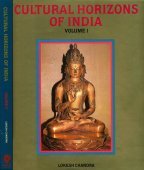Yogishvara, Yogīśvara, Yogi-ishvara: 12 definitions
Introduction:
Yogishvara means something in Hinduism, Sanskrit, Jainism, Prakrit. If you want to know the exact meaning, history, etymology or English translation of this term then check out the descriptions on this page. Add your comment or reference to a book if you want to contribute to this summary article.
The Sanskrit term Yogīśvara can be transliterated into English as Yogisvara or Yogishvara, using the IAST transliteration scheme (?).
Images (photo gallery)
In Hinduism
Shilpashastra (iconography)
Source: archive.org: Pratima Kosa Encyclopedia of Indian Iconography - Vol 6Yogīśvara (योगीश्वर) refers to one of the many varieties of the Śālagrāma (ammonite fossil stones).—The Yogīśvara has a liṅga-like protuberance on top. Śālagrāma stones are very ancient geological specimens, rendered rounded and smooth by water-currents in a great length of time. They (e.g., Yogīśvara stones) are distinguished by the ammonite (śālā, described as “vajra-kīṭa”, “adamantine worms”) which having entered into them for residence, are fossilized in course of time, leaving discus-like marks inside the stone.

Shilpashastra (शिल्पशास्त्र, śilpaśāstra) represents the ancient Indian science (shastra) of creative arts (shilpa) such as sculpture, iconography and painting. Closely related to Vastushastra (architecture), they often share the same literature.
Purana and Itihasa (epic history)
Source: archive.org: Puranic EncyclopediaYogīśvara (योगीश्वर).—A community of famous yogins. Kavi, Hari, Antarikṣa, Prabuddha, Pippalāyana, Āvirhotra, Drumila, Camasa and Karabhojana belonged to this community. They were the sons of the sage Ṛṣabha and used to go about naked, everywhere. This community of yogins participated in the yajña of Nimi, King of Mithilā and gave him advice on Bhāgavatadharma. (Bhāgavata, 4th Skandha).

The Purana (पुराण, purāṇas) refers to Sanskrit literature preserving ancient India’s vast cultural history, including historical legends, religious ceremonies, various arts and sciences. The eighteen mahapuranas total over 400,000 shlokas (metrical couplets) and date to at least several centuries BCE.
Yoga (school of philosophy)
Source: ORA: Amanaska (king of all yogas): A Critical Edition and Annotated Translation by Jason BirchYogīśvara (योगीश्वर) refers to the “lords of Yoga”, according to the 17th century Yogacintāmaṇi by Śivānanda: a large compilation of roughly 3423 verses dealing with the various methods of (Haṭha) Yoga and Aṣṭāṅgayoga.—Accordingly, “Having bowed to the venerable Vyāsa; the ascetic, Śaṅkara, [who is] the guru of the world; [his own] guru, the venerable Rāmacandra, whose lotus feet are intense bliss, and all the lords of Yoga (yogīśvara), the ascetic Śivānanda has written clearly the Yogacintāmaṇi [which] is derived from an ocean of various scriptures and is capable of [conveying] their entire meaning”.

Yoga is originally considered a branch of Hindu philosophy (astika), but both ancient and modern Yoga combine the physical, mental and spiritual. Yoga teaches various physical techniques also known as āsanas (postures), used for various purposes (eg., meditation, contemplation, relaxation).
In Jainism
General definition (in Jainism)
Source: The University of Sydney: A study of the Twelve ReflectionsYogīśvara (योगीश्वर) refers to the “lords of Yogīs” (i.e., the Jinas), according to the 11th century Jñānārṇava, a treatise on Jain Yoga in roughly 2200 Sanskrit verses composed by Śubhacandra.—Accordingly, “Certainly, O friend, these twelve reflections are the female friends of those whose good fortune is liberation [and] they are practised to procure their friendship by wise men who are absorbed in connection [with them]. When these [reflections] are correctly done constantly for the pleasure of the lords of Yogīs (yogīśvara) (i.e. the Jinas), a joyful woman in the form of liberation with a heart kindly disposed to love, is produced”.

Jainism is an Indian religion of Dharma whose doctrine revolves around harmlessness (ahimsa) towards every living being. The two major branches (Digambara and Svetambara) of Jainism stimulate self-control (or, shramana, ‘self-reliance’) and spiritual development through a path of peace for the soul to progess to the ultimate goal.
Languages of India and abroad
Sanskrit dictionary
Source: Cologne Digital Sanskrit Dictionaries: Cappeller Sanskrit-English DictionaryYogīśvara (योगीश्वर).—[masculine] a master of sorcery or the chief among devotees, [Epithet] of Yajnavalkya.
Source: Cologne Digital Sanskrit Dictionaries: Aufrecht Catalogus Catalogorum1) Yogīśvara (योगीश्वर) as mentioned in Aufrecht’s Catalogus Catalogorum:—a title of Yājñavalkya.
2) Yogīśvara (योगीश्वर):—Dānavākyasamuccaya.
Source: Cologne Digital Sanskrit Dictionaries: Monier-Williams Sanskrit-English Dictionary1) Yogīśvara (योगीश्वर):—[from yogi > yoga] m. = [preceding] [Kāvya literature; Yājñavalkya]
2) [v.s. ...] a master in sorcery, [Kathāsaritsāgara]
Source: DDSA: Paia-sadda-mahannavo; a comprehensive Prakrit Hindi dictionary (S)Yogīśvara (योगीश्वर) in the Sanskrit language is related to the Prakrit word: Joīsara.
[Sanskrit to German]
Sanskrit, also spelled संस्कृतम् (saṃskṛtam), is an ancient language of India commonly seen as the grandmother of the Indo-European language family (even English!). Closely allied with Prakrit and Pali, Sanskrit is more exhaustive in both grammar and terms and has the most extensive collection of literature in the world, greatly surpassing its sister-languages Greek and Latin.
Kannada-English dictionary
Source: Alar: Kannada-English corpusYōgīśvara (ಯೋಗೀಶ್ವರ):—
1) [noun] a man of excellent yogic merits or achievements.
2) [noun] Křṣṇa.
Kannada is a Dravidian language (as opposed to the Indo-European language family) mainly spoken in the southwestern region of India.
Nepali dictionary
Source: unoes: Nepali-English DictionaryYogīśvara (योगीश्वर):—n. 1. → योगेश्वर [yogeśvara ] ; 2. Mythol. an epithet of Shiva; 3. Mythol. an epithet of Krishna;
Nepali is the primary language of the Nepalese people counting almost 20 million native speakers. The country of Nepal is situated in the Himalaya mountain range to the north of India.
See also (Relevant definitions)
Partial matches: Ishvara, Yogin, Yogi, Yoki.
Ends with: Siddhayogishvara.
Full-text: Yokicuvaran, Yogishvari, Joisara, Danavakyasamuccaya, Yogishvar, Siddhayogishvara, Samudra, Krishnavadhuta.
Relevant text
Search found 14 books and stories containing Yogishvara, Yogīśvara, Yogi-ishvara, Yogi-isvara, Yogin-īśvara, Yogī-īśvara, Yogin-ishvara, Yōgīśvara, Yogisvara, Yogin-isvara, Yogi-īśvara; (plurals include: Yogishvaras, Yogīśvaras, ishvaras, isvaras, īśvaras, Yōgīśvaras, Yogisvaras). You can also click to the full overview containing English textual excerpts. Below are direct links for the most relevant articles:
Blue Annals (deb-ther sngon-po) (by George N. Roerich)
Chapter 11 - Drigung Chojay lineage (i): ‘bri khung pa’s precious descendents < [Book 8 - The famous Dakpo Kagyü (traditions)]
Vedic influence on the Sun-worship in the Puranas (by Goswami Mitali)
Part 6 - Sūrya, the Ultimate Reality < [Chapter 4 - Vedic Influence on the Sun-Worship in the Purāṇas]
Chaitanya Bhagavata (by Bhumipati Dāsa)
Verse 1.1.50 < [Chapter 1 - Summary of Lord Gaura’s Pastimes]
Brihad Bhagavatamrita (commentary) (by Śrī Śrīmad Bhaktivedānta Nārāyana Gosvāmī Mahārāja)
Verse 1.3.28-31 < [Chapter 3 - Prapañcātīta (beyond the Material Plane)]
Yoga-sutras (with Vyasa and Vachaspati Mishra) (by Rama Prasada)
Sūtra 4.5 < [Book 4 - Absolute Independence (Kaivalya)]
The Skanda Purana (by G. V. Tagare)
Chapter 52 - Greatness of Rudrakoṭi < [Section 1 - Tīrtha-māhātmya]
Chapter 213 - Efficacy of Kuhara-vāsi-Sāṃbāditya < [Section 1 - Tīrtha-māhātmya]
Chapter 42 - The Greatness of Pippalāda Tīrtha < [Section 3 - Revā-khaṇḍa]
Related products

